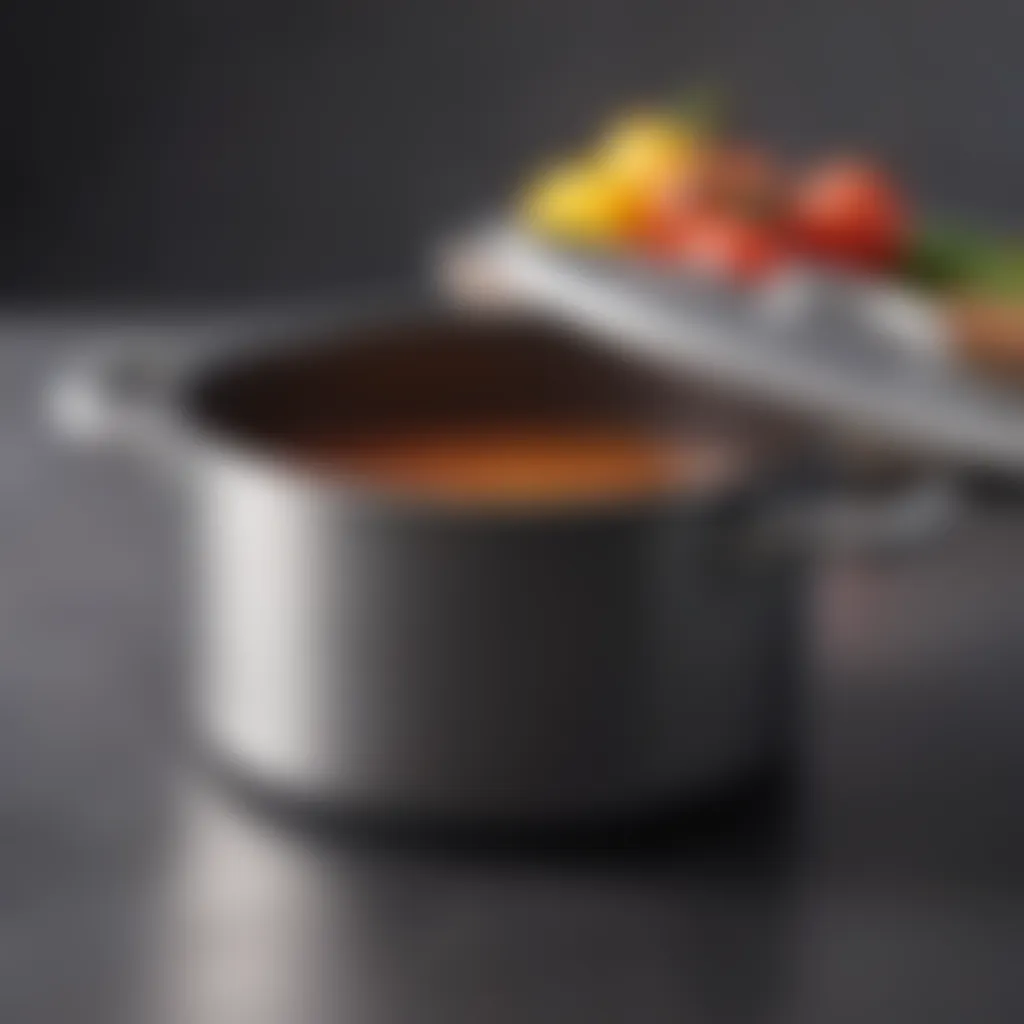Exploring Safe Nonstick Cookware: Materials and Health


Intro
The choice of cookware is fundamental in any kitchen. In recent years, nonstick pots and pans have gained popularity due to their convenience and ease of cleaning. However, safety concerns surround their use, with varying opinions on the materials used and their health implications. This article aims to provide an in-depth examination of safe nonstick cookware. It will cover materials, health impacts, and environmental considerations, empowering homemakers to make educated choices.
Ingredients:
When preparing meals with nonstick cookware, it is essential to consider not just the food itself but also the cookware's compatibility with the cooking ingredients. Below is a list of common ingredients used in various recipes, along with their exact measurements.
- 2 tablespoons of olive oil
- 4 boneless chicken breasts (about 1.5 pounds)
- Salt and pepper to taste
- 1 teaspoon of garlic powder
- 1 teaspoon of paprika
- 1 cup of diced tomatoes
- 1 cup of chopped spinach
- 1 tablespoon of fresh basil, chopped
- 1 cup of grated mozzarella cheese
Preparation Steps:
Detailed Instructions:
- Prepare the chicken: Pat the chicken breasts dry with a paper towel. This will help them brown better in the pan.
- Season the chicken: Sprinkle salt, pepper, garlic powder, and paprika on both sides of the chicken to enhance the flavor.
- Chop the vegetables: Dice the tomatoes and chop the spinach and basil in a separate bowl. Keep them ready for later use.
- Preheat the nonstick pan: Heat your safe nonstick skillet over medium heat. Make sure it's heated properly before adding any oil.
Technical Aspects:
Temperature Settings and Timing:
- Set the stove to medium heat while preheating.
- Allow about 2-3 minutes for the pan to heat before adding the olive oil.
- Cook the chicken for about 6-7 minutes on each side or until golden brown and cooked through, reaching an internal temperature of 165°F (75°C).
Critical Techniques:
- Use a meat thermometer to ensure the chicken reaches the right temperature.
- Avoid overcrowding the pan, as this reduces cooking temperature and can lead to uneven cooking.
Cooking Process:
Sequential Steps:
- Add the oil: Once the pan is hot, add the olive oil and spread it evenly.
- Cook the chicken: Place the chicken breasts in the pan. Avoid moving them too much to ensure a good sear.
- Add tomatoes and spinach: After flipping the chicken for the first time, add the diced tomatoes and chopped spinach into the pan, allowing them to cook down slightly.
- Top with cheese: Finally, sprinkle the mozzarella cheese on top, covering the pan with a lid to help it melt.
- Garnish: Serve with a sprinkle of fresh basil over the top.
Troubleshooting Tips:
If any issues arise during cooking, here are some common solutions:
- If the chicken is not browning, ensure the pan is adequately heated before adding the oil.
- For burnt bits, lower the heat slightly and stir the vegetables to deglaze the pan.
- If the cheese is not melting, allowing more time under the lid can help.
This guide intends to streamline the cooking process while using nonstick pots and pans. Understanding the ingredients, steps, and techniques will ensure a positive cooking experience while harnessing the benefits of safe nonstick materials.
Understanding Nonstick Cookware
Nonstick cookware has transformed the way many people prepare meals. Its primary benefit is the ease of cooking without the need for excessive oil or fat, making it a popular choice among health-conscious individuals. Nonstick pans and pots reduce food sticking, ensuring simpler cooking and, importantly, easier cleaning. However, understanding the intricacies of nonstick cookware is vital to make informed choices in a saturated market.
Knowledge about material composition, safety concerns, and the latest advancements in coating technologies can significantly influence purchasing decisions. Households increasingly seek cookware that not only performs well but also aligns with health and environmental values. With its widespread use, knowledge about nonstick cookware can enhance both culinary success and personal safety.
History of Nonstick Cookware
The journey of nonstick cookware dates back to the mid-20th century when Teflon was first introduced. Initially used for military applications, Teflon found its way into kitchens and became immensely popular. The benefits of nonstick surfaces allowed amateur cooks and experts alike to reduce cooking times significantly and create healthier meals with less oil.
During the years, various brands began to create their own versions of nonstick coatings, yet concerns arose about chemical safety, particularly with products containing polytetrafluoroethylene (PTFE). The discovery of potential hazards associated with traditional nonstick coatings led consumers to demand safer, healthier alternatives. As a response, manufacturers began developing newer materials and coatings to meet these expectations, shaping the cookware landscape we see today.
How Nonstick Cookware Works


At its simplest, nonstick cookware works by utilizing a specially formulated coating that reduces friction between the cookware surface and food. The common material, Teflon, creates a smooth, slippery surface that prevents food from sticking when heated.
To enhance nonstick properties, manufacturers often employ various techniques during production. For example, some cookware features ceramic coatings, which offer similar nonstick advantages but typically without the same safety concerns.
Regardless of the technology behind it, maintaining the nonstick characteristics requires proper care and handling. High heat, metal utensils, and abrasive cleaning tools can compromise the surfaces, eliminating the benefit of easy cooking and cleaning. Understanding these operational nuances can drastically extend the lifespan of nonstick cookware and ensure it delivers the optimal cooking experience.
Material Composition
Material composition is crucial when discussing nonstick cookware. The type of materials used in pots and pans determines not only their performance in the kitchen but also their safety and durability. Understanding these materials helps consumers make knowledgeable choices.
Common Nonstick Coatings
Most nonstick cookware uses a coating to enhance food release and reduce the amount of oil needed during cooking. The most common material used for nonstick coatings is polytetrafluoroethylene, better known by the brand name Teflon. Teflon provides excellent nonstick properties, making it a popular choice for many home cooks.
Furthermore, ceramic coatings have gained popularity as a healthier alternative. They are made from sand and provide a naturally nonstick surface without the potential health risks associated with traditional Teflon coatings. This makes them a viable choice for those seeking nonstick options without compromising safety.
Another new wave of coatings includes titanium-based nonstick surfaces. These offer enhanced scratch resistance and durability compared to conventional coatings.
Health Risks Associated with Standard Coatings
While nonstick coatings are convenient, there are health risks linked to some common types. The primary concern with traditional Teflon-coated cookware is the potential release of toxic fumes when heated to high temperatures. These fumes can be harmful, particularly to pet birds, which can experience respiratory distress when exposed. Though Teflon itself is considered safe at normal cooking temperatures, overheating it poses significant risks.
In addition, older nonstick cookware often contained perfluorooctanoic acid (PFOA), a chemical that has raised health concerns due to its potential links to cancer and other serious health issues. Most reputable manufacturers have phased out PFOA, meaning newer cookware is generally safer, but vigilance is still necessary.
Emerging Safe Technologies
In response to health concerns, emerging safe technologies in nonstick cookware are gaining attention. Next-generation coatings include products that are free from harmful chemicals like PFOA. For instance, some cookware companies have developed nonstick surfaces using cast iron with enamel finishes, providing natural nonstick capabilities while maintaining safety.
Other innovative materials include water-based nonstick coatings that do not use chemicals harmful to health. These coatings are made more robust through advanced manufacturing processes, making them durable while being environmentally friendly. As technology advances, consumers can expect even better nonstick options that prioritize safety without sacrificing cooking performance.
Health Implications
Understanding the health implications of nonstick cookware is essential for anyone committed to healthy cooking and food safety. In recent years, there has been growing concern regarding the potential hazards associated with traditional nonstick coatings. These coatings often contain chemicals that can pose risks to human health, both during cooking and when the cookware is used or disposed of. Knowing these risks helps consumers make informed decisions about their kitchenware choices, which is crucial for ensuring the safety of meals prepared for families.
Potential Hazards of Traditional Nonstick Coatings
Traditional nonstick pans are usually coated with polytetrafluoroethylene, commonly known as Teflon. One significant hazard is the release of toxic fumes when these pans are overheated. This can occur at temperatures exceeding 500 degrees Fahrenheit. Such fumes can cause flu-like symptoms in humans and can be fatal to birds. Additionally, older nonstick coatings may contain perfluorooctanoic acid (PFOA), a substance linked to various health issues, including cancers and thyroid problems. Although PFOA is being phased out in many products, the memory of its dangers persists, fostering distrust in nonstick cookware.
Furthermore, the potential for scratches and degradation in the coating raises concerns about ingestion of harmful particles. Proper care can mitigate these issues, but daily wear and tear can still pose a risk. Even without visible damage, the coatings might emit hazardous substances over time.
Regulations and Safety Standards
Public awareness of health risks has led to stricter regulations regarding nonstick cookware production. In many countries, regulatory bodies have established safety standards that manufacturers must follow. For instance, the U.S. Environmental Protection Agency (EPA) has worked to limit the use of certain hazardous chemicals in cookware.
Consumers can look for cookware certified by organizations that ensure safety and compliance with such regulations. Knowing how to identify these certifications is vital for making safe choices. Look for labels indicating PFOA-free or BPA-free products, as these designations signify that the cookware meets specific safety standards.
"Investing in safe nonstick cookware today means safeguarding your family’s health tomorrow."
Choosing Safe Nonstick Cookware
Choosing safe nonstick cookware is vital for anyone who enjoys cooking. The shift towards healthier options in the kitchen has become essential as consumers are more aware of what they are using to prepare their meals. Nonstick cookware can make cooking easier and more enjoyable, but the safety of the materials used is of utmost importance. The right choices can prevent harmful substances from leeching into food while ensuring the durability and usability of the cookware.
Safe nonstick cookware often features improved materials that do not contain harmful chemicals found in traditional options. Understanding which brands and products offer safety guarantees is crucial. Readers should be diligent in their research and ensure that their cookware is certified and well-reviewed.


Identifying Safe Brands
Identifying safe brands of nonstick cookware involves evaluating several factors. First, brand reputation plays a significant role. Reputable brands tend to prioritize health standards and consumer safety. Look for brands such as Tefal and GreenPan, which are known for their commitment to safer cooking solutions. Additionally, a brand's commitment to transparency about materials and manufacturing processes is important. Inspecting whether they disclose any potentially harmful ingredients helps consumers make informed decisions.
Moreover, consider the durability of the cookware. Brands that offer warranties or guarantees often stand behind the quality of their products. Customer feedback about prolonged use can also highlight any issues related to safety, nonstick performance, and overall satisfaction.
Certification Labels to Look For
Certification labels are a reliable indicator of a product's safety. Products with trusted certifications indicate compliance with established health and safety criteria. Some notable labels to look for include:
- PFOA-free – Ensures that the cookware does not contain perfluorooctanoic acid, a chemical linked to health risks.
- FDA-approved – Confirms that materials used have met safety standards set by the Food and Drug Administration.
- NSF International Certification – Represents a high standard of product safety and quality.
It is also important to be skeptical of vague claims such as "safe" or "green" without proper substantiation. Always verify claims through recognized certification programs.
Consumer Reviews and Feedback
Consumer reviews and feedback are invaluable for assessing the safety and performance of nonstick cookware. Real-world experiences from other users provide insight that might not be covered in marketing materials. Seek out platforms where users share their stories and opinions, such as Reddit or product-specific forums.
Pay attention to both positive and negative reviews. Look for patterns in feedback – for example, consistent reports of flaking or chemical odors might raise red flags. Understanding how well a product has performed in everyday cooking environments can guide safer purchasing decisions.
"Choosing the right nonstick cookware means prioritizing safety and health. Consumers can make informed decisions by evaluating brands, certifications, and feedback."
Maintenance and Care
When it comes to nonstick cookware, proper maintenance and care are vital for ensuring durability and safe cooking experiences. Many consumers overlook how essential these practices are for enhancing the lifespan of their kitchen tools. The longevity of nonstick properties can heavily depend on how one cleans and uses their cookware. Therefore, understanding the right maintenance techniques not only preserves the nonstick surface but also aids in maintaining safety standards associated with its use. Regular care can help eliminate concerns regarding wear and tear, while also ensuring that the cookware remains effective in the kitchen.
Cleaning Nonstick Cookware Safely
The first step in caring for nonstick cookware is an effective cleaning routine. It is crucial to follow specific cleaning practices to maintain the nonstick coating. Here are some key guidelines:
- Use Gentle Detergents: Choose mild dish soap that does not contain abrasives. This minimizes the risk of damaging the nonstick surface.
- Avoid Steel Wool: Scrubbers made of steel wool or similar materials can scratch the nonstick coating. Instead, opt for soft sponges or cloths.
- Cool Down First: After cooking, let the pan cool down to a manageable temperature before cleaning. Sudden temperature changes can warp the cookware.
- Hand Wash Preferred: It is advisable to hand wash nonstick pots and pans instead of putting them in a dishwasher. High temperatures and harsh additives in dishwashing detergents can deteriorate the coating.
By adhering to these cleaning methods, consumers can enjoy both the aesthetic and functional benefits of their nonstick cookware while prolonging its life.
Maintaining Nonstick Properties Long-term
Beyond cleaning, there are additional strategies to help retain the nonstick properties of cookware over time. Here are some suggestions for effective long-term maintenance:
- Regular Seasoning: Occasionally, seasoning the nonstick surface can enhance its performance. Lightly coat the surface with oil after cleaning and heat it on low for a few minutes. This reinforces the nonstick layer.
- Use Appropriate Utensils: Cooking tools made from wood, silicone, or plastic are ideal for nonstick cookware. Metal utensils can scratch and damage the coating.
- Store Properly: Avoid stacking nonstick pots and pans directly onto each other. Instead, use pot protectors or place a soft cloth between them to prevent surface scratching.
- Monitor for Damage: Regularly inspect cookware for any signs of peeling or chipping. If any damage is noted, it may be better to replace the item to avoid contaminating food.
By following these routine practices, users can help ensure their nonstick cookware provides safe and efficient cooking for years ahead.
"Proper care is the key to the longevity of your nonstick cookware, transforming it from a simple kitchen tool into a reliable companion."
For anyone invested in quality kitchenware, understanding the importance of maintenance and care will result in healthier cooking environments and improved culinary experiences.
Alternatives to Nonstick Cookware
When considering the vast array of cooking options available, the topic of safe alternatives to nonstick cookware is critical. Many consumers are drawn to the convenience offered by nonstick surfaces. However, concerns around health implications and environmental impact have grown. Exploring alternatives allows cooks to enjoy efficiency without compromising safety or sustainability.
Stainless Steel Cookware
Stainless steel cookware is a well-regarded alternative to nonstick options. It is durable and resistant to rust, corrosion, and staining. This material does not react with foods, which makes it a safe choice for cooking. Additionally, stainless steel can withstand high temperatures. This versatility allows for various cooking methods, such as frying, sautéing, and searing. An advantage of stainless steel is its ability to maintain heat effectively, meaning food cooks evenly.


However, there is a learning curve. Food may stick to stainless steel pans if not used correctly. Preheating the pan and using adequate amounts of oil can help minimize this issue. Another consideration is that stainless steel cookware typically requires more maintenance than its nonstick counterparts. Proper cleaning is needed to maintain its appearance and performance.
Cast Iron Cookware
Cast iron cookware is another strong alternative. Renowned for its heat retention properties, cast iron is ideal for slow cooking and baking. It adds a unique flavor to dishes and is perfect for searing meats. Cast iron can go from stovetop to oven seamlessly, which enhances its usability.
An important aspect of cast iron is the seasoning process. Seasoning creates a natural nonstick surface, which prevents food from sticking. Regular maintenance is key to ensure longevity. However, cast iron does require some effort in terms of care, including proper cleaning and occasional re-seasoning. This cookware is heavy, which can be a consideration for some users.
Ceramic Coated Cookware
Ceramic coated cookware offers a different approach than traditional nonstick options. These coatings are generally derived from natural materials and are free from harmful chemicals found in some conventional nonstick coatings. Ceramic pans distribute heat evenly and can handle moderate temperatures well.
Ceramic cookware is easy to clean, often requiring just a simple wipe. It is important to note that while ceramic coatings can provide nonstick properties, they may wear down over time. Users should avoid using metal utensils to prolong the lifespan of the coating. Furthermore, ceramic cookware is available in various colors and styles, allowing for aesthetic choices in the kitchen.
"Choosing the right cookware can enhance your cooking experience, ensuring health and safety in meal preparations."
In summary, when opting for cookware, it is essential to consider safety, durability, and ease of maintenance. Stainless steel, cast iron, and ceramic coated cookware each offer unique benefits for various culinary needs. Exploring these alternatives empowers individuals in their cooking journey while addressing health and environmental concerns.
Environmental Considerations
Understanding the environmental impact of nonstick cookware is essential for making responsible choices in the kitchen. This consideration is not merely about the cookware's performance but also its broader consequences on nature. As awareness around sustainable living grows, the need to evaluate products we use regularly has become more pressing. This section examines how traditional nonstick coatings affect the environment and offers insights into more sustainable alternatives.
Impact of Nonstick Coatings on the Environment
Nonstick coatings, typically made from polytetrafluoroethylene (PTFE), have raised concerns regarding their environmental footprint. The production of PTFE involves chemicals that can be harmful to the environment. When nonstick cookware is produced, the process can emit perfluorinated compounds (PFCs), which are persistent in the environment and can bioaccumulate in the food chain.
Furthermore, once nonstick pans reach the end of their life cycle, they contribute to waste. Many are not recyclable due to the coatings. This leads to an increase in landfill waste, posing a significant problem as these materials can take years to decompose. It is worthy to note:
- PFCs and Pollution: These chemicals have been linked to health issues and are persistent pollutants.
- Landfill Impact: Nonstick cookware often ends up in landfills, where it contributes to long-term waste issues.
The focus on sustainability highlights these issues, pushing manufacturers to rethink how they create and dispose of cookware.
Sustainable Alternatives in Cookware
Given the environmental concerns, exploring sustainable alternatives becomes imperative for conscientious consumers. Options that reduce environmental impact are becoming more widely available. Here are some alternatives to consider:
- Stainless Steel Cookware: Durable and recyclable, stainless steel pans have no harmful coatings. They provide excellent heat conduction and are less likely to warp over time.
- Cast Iron Cookware: Cast iron is known for its longevity, and when properly cared for, it can last for generations. It requires regular seasoning, but this creates a natural nonstick surface without harmful chemicals.
- Ceramic Coated Cookware: Ceramic coatings offer a nonstick alternative without the same environmental impact as PTFE. They are usually made from sand and are more biodegradable, although they can vary in durability.
When looking for cookware, consider these options to minimize your environmental footprint. In the end, making informed decisions about the cookware you choose can contribute to a healthier planet.
The Future of Nonstick Cookware
The future of nonstick cookware holds significant relevance in our current culinary landscape. As consumers become more aware of the health impacts linked with certain nonstick coatings, cookware manufacturers are increasingly investing in safer and more sustainable materials. This shift is essential for two primary reasons: consumer safety and environmental sustainability. Nonstick cookware should not only enhance cooking efficiency but also align with health-conscious choices. Therefore, understanding where this market is heading is crucial for anyone looking to make informed purchasing decisions.
Innovations in Nonstick Technology
Recent advancements in nonstick technology are reshaping the cookware aisle. Companies are exploring new engineered materials that provide effective nonstick surfaces without the harmful components commonly associated with traditional coatings. For example, some manufacturers are now utilizing ceramic-based coatings, which offer a safe alternative. These coatings contain no PTFE or PFOA, making them healthier for both users and the environment.
- Thermal Stability: New technologies focus on thermal stability, allowing the cookware to withstand high temperatures without degrading.
- Durability: Enhanced durability means that these products can last longer, reducing the need for frequent replacements, which is beneficial in reducing waste.
- Improved Performance: Innovations also aim to improve cooking performance, leading to better heat distribution and food release.
These technological advancements not only make cooking easier but also offer peace of mind to those concerned with health implications.
Consumer Trends Towards Safety and Sustainability
The growing trend among consumers significantly influences the nonstick cookware market. Shoppers today are increasingly prioritizing safety and sustainability when making purchasing choices. This shift stems from a broader societal focus on health and environmental issues.
- Health-Conscious Purchases: Information on the potential hazards of traditional nonstick coatings has led many to seek alternatives that promise safety, such as ceramic or stainless steel.
- Sustainability Awareness: More consumers are interested in the materials and manufacturing processes used in cookware production. They are looking for brands that emphasize eco-friendliness, both in their product offerings and packaging.
- Product Transparency: There is a rising demand for transparency from brands about the materials and chemicals used, ensuring that consumers know exactly what they are cooking with.
Embracing these trends, manufactures now tailor their products to meet consumer demands, focusing on innovation while enhancing safety and reducing environmental impact. This ongoing evolution reflects a broader commitment to responsibility in the cookware industry, paving the way for a more conscientious future in culinary practices.
"The future of nonstick cookware is not just about convenience and performance, but also health and sustainability."







